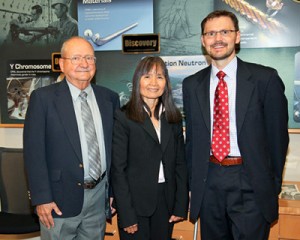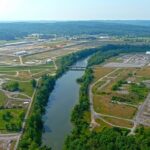
Radiation Safety Information Computational Center directors at Tuesday’s celebration were Robert Roussin (1987-96), Bernadette Kirk (1996-2000 and 2004-11), and Tim Valentine (current). (Photo by Curtis Boles)
One of Oak Ridge National Laboratory’s longest-running institutions marked its golden anniversary on Tuesday with a recognition ceremony keynoted by U.S. Department of Energy Assistant Secretary for Nuclear Energy Peter Lyons, a press release said.
The Radiation Safety Information Computational Center has been a storehouse of invaluable nuclear computational tools and data for modeling and simulating the interaction of radiation with matter since 1962, the release said. The center acquires the state-of-the art codes and data, preserves them, and makes them accessible to the research community.
“Congratulations to the RSICC in its 50th year,” Lyons said. “RSICC’s innovative and adaptive culture has enabled the center to continuously provide a unique service to its nearly 20,000 customers around the world.”
The DOE center has expanded its software and data packages beyond radiation shielding to areas that include criticality safety, radiation protection, reactor physics, atmospheric dispersion and environmental dose, radiation dose in medical applications and space shielding applications, the release said.
The idea for the RSICC, like many that emanated from ORNL during the Cold War, can be traced to the late Alvin Weinberg, who as ORNL director chaired a president’s advisory council convened to deal with the expanse of new data emerging from the nuclear science community. The council recommended the establishment of information analysis centers.
The press release said computer codes and the nuclear data are extremely important to anyone working with nuclear materials. Luiz Leal, a distinguished researcher in the Lab’s Nuclear Data and Criticality Safety group, explained why.
“Computational methods rely on mathematical models and neutron cross sections to describe the interaction of radiation with matter,” Leal said. “The nuclear cross-section represents the probability of a particular interaction and is used in computational models to estimate nuclear reaction rates of interest for many different applications, whether it be dose rates or damage to materials.”
The center’s newsletter has documented events, conferences, and training in the realm of radiation safety related software and data since the center was formed, the press release said. RSICC just published its 569th issue.
“Unlike many federal endeavors, RSICC’s existence is not based on a unique facility but on an enduring vision that collection, preservation and distribution of scientific tools and data are essential for the evolution of nuclear technology as well as for the education and training of the next generation of scientists and engineers,” RSICC Director Timothy Valentine said.
RSICC is funded by DOE’s Office of Nuclear Energy, the National Nuclear Security Administration’s Nuclear Criticality Program, the NNSA’s Nonproliferation Programs, and the Nuclear Regulatory Commission.





Leave a Reply